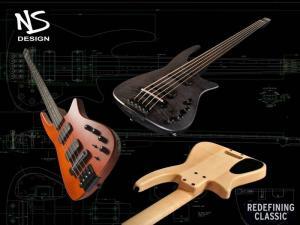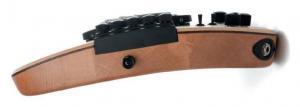Music instrument aesthetics are rarely, if ever, considered from a scientific point of view. Yet for industrial designers and architects, form must meet function. And there is a lot of science and technology to apply in this way.
While technique for playing bass is often the subject of passionate discussion, and there are varying theories (plectrum, fingers, slap, tap, Simandl method, one note per fret method, etc.) the design of the instrument itself has a lot to do with the overall playability of the bass and the ability of the player to successfully use those techniques. When the very first electric bass was created it was just a squared, slab of wood with no cuts or rounded/beveled edges. Ergonomics took a backseat to sound production. And while there were changes over the years, they were an answer to specific player issues and ideas rather than a look directly at design. Even today, most of the emphasis and science in the music instrument industry goes into the materials and electronics of the instruments. Guitar and bass aesthetics are merely a function of what is pleasing or challenging to the eye.
Ned Steinberger is synonymous with innovative headless instruments. Yet it is not as well known that Ned designed the body of one of the most iconic basses of all time, the Spector NS-2 bass. Yes, the NS stands for Ned Steinberger. As a furniture designer and builder specializing in chairs, Ned understood that function and form are all essential to an aesthetically pleasing, yet functional piece of furniture. And it was in that Brooklyn co-op that he shared with some up and coming guitar and bass builders where he first applied those principles to music instruments. In collaboration with Stuart Spector, he designed something radical for the time, a rounded, radiused bass body with cuts and carves that naturally fell against the body of the player, making the bass exponentially more comfortable and easier to play. His body shape has been copied numerous times over the years, by some of the world’s largest guitar manufacturers.
With the NS Design Radius Bass, Ned uses ergonomic science and technology and has taken the body contour to a whole new level. While maintaining and refining the back body curve cut so that the bass lies on the player’s body comfortably, the front of NS Diradial™ Body has a 20 inch radius, which, in combination with the general wedge shape of the body, shifts it into more comfortable orientation for the right and left hand. The slight wedge shape of the body tilts the body and neck slightly inward so the fingerboard is more visible to the player, and the concave curve on the back of the body creates a more stable platform. The radius of the bass is continued along the entire body, to include pickups and bridge, to optimize the playability and comfort of the bass.
The pictures show how the radius has been built into the bass. Built in based on technology.
Simple, yet intuitive. Form, science, and engineering meeting function.


